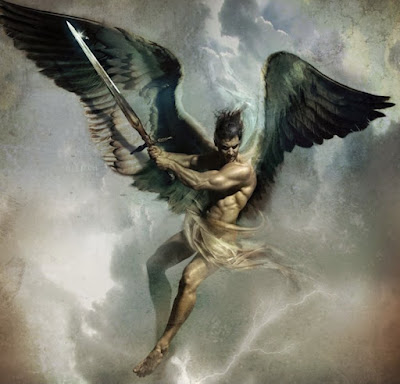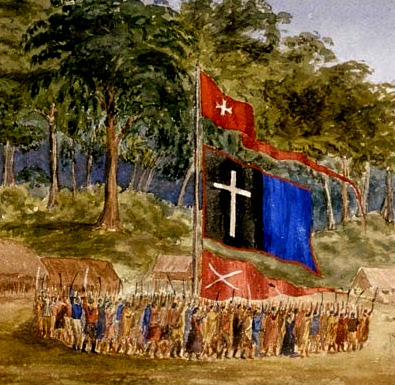Soldier’s Severed Head Inspires Holy War
Maori traditionally used dried heads of enemies to raise war-parties.
After the ambush and slaughter of troopers by Hauhau at Ahuahu on 6 April 1864 (see my post “How Captain Lloyd Lost his Head” below) their heads were cut off on the spot and later dried as trophies - according to Maori custom.
The Hauhau were an aggressive development of the original teachings of the Maori prophet Te Ua who founded the peaceful Pai Maririe religion in Taranaki in 1862.
Shortly after Ahuahu Te Ua revealed that he had been visited (again) by the Angel Gabriel - whose instructions were that Captain Lloyd’s head was to be carried as a victorious religious tropy throughout the North Island in a stirring (but peaceful) recruiting drive to draw Maori to the Pai Maririe cause: which was basically an attempt to stop the loss of tribal lands to predatory carpet-baggers and land-sharks from Britain.
Below; the Angel Gabriel:
However, the militant emissaries entrusted with this task instead saw their role as encouraging Maori to rise-up in arms and wage a holy war to totally destroy the White race. As part of their recruiting campaign their group carried several dried White heads (among them Captain Lloyd's head, which, mounted on a tray, was carried by a White captive). The use of trophy heads to exhibit and denigrate before an allied tribe in order to raise blood-lust was an ancient Maori custom.
Below: Captain Lloyd, 57th Reg. killed Apl. 1864. circa 1860, maker unknown. Purchased 1916. Te Papa (O.013178/01)
Leading Pai Maririe prophet Matene Rangi-tauira travelled with a party to Pipiriki on the Whanganui River. Matene was a Taranaki chief, and had taken part in the Ahuahu killings.
At Pipiriki a niu pole was erected and “.....the prophet Matene...a tall man with long hair and a flowing black beard....led the people in their newly learned chantings, and round and round the sacred mast the half-crazed devotees marched....whirling round and round until they sank at its foot in a fit of giddiness and religious mania. The white man's head was passed from hand to hand among the frenzied worshippers, and there were some extraordinary scenes of fanatic fury. Some of the people, particularly those who had lost relatives in the Taranaki War, gnawed the dried flesh in their demonstrations of hatred and revenge. One, a handsome young woman, who had been brought up in Mr. Booth's family and who had been regarded as a quiet, gentle girl, was so overcome by the new madness that she snatched the pakeha's head from her neighbour at the niu and bit the flesh of the neck with horrible savagery. The people, indeed, were transformed by Matene's teachings; the appeal to the feelings of revenge swept them along irresistibly.....”
From James Cowan - The New Zealand Wars: A History of the Maori Campaigns and the Pioneering Period: Volume II: The Hauhau Wars, 1864–72
Below: Hauhau and the niu pole:
The Maori warriors slain in the massacre at Sentry Hill, as well as other recent engagements with soldiers, were mainly upper Whanganui River Maori, so their kinsman Matene’s call for utu was enthusiastically received at Pipiriki, and a war-party headed south to attack the white settlement at Wanganui.
However, lower-river Maori were greatly benefiting from trade with the settlers, and so were determined to stop this threat to their Pakeha, and to protect the mana of their section of the river from invaders.
The mid-river island of Moutoa (between Ranana and Jerusalem) was a traditional ground for settling disputes between the river tribes, and so the opposing parties agreed to settle the issue there by arms.
Cowan again: “Very early in the morning [14 May 1864] the picked warriors of the Hauhau force, numbering about a hundred and twenty, crossed over in state to the island for battle.... they crossed with all ceremony in their great canoes, carved, painted, and plumed for war. Grounding the canoes on the shingly beach at the upper end of the island, they leaped ashore and lined up for the war-dance, the necessary prelude to battle. The eager spectators, gathered on the green terrace at Tawhitinui, saw their warriors dance their peruperu, led off by the big blackbearded prophet...”
Meanwhile, earth ovens were being prepared by both sides in eager anticipation of a sumptious celebratory feast on the fallen, but again the Hauhau chants and spells failed, and determined resistance carried the day for the lower-river warriors.
Below: Hauhau haka:
Cowan: “The finale to this great tournament was the killing of Matene Rangi-tauira the prophet. He had received a wound, and was swimming across the river to the right bank. [Chief] Haimona Hiroti, standing on the gravel beach of Moutoa, gave his whalebone club to one of his men, [Te Moro] and, pointing to the shaggy black head of the struggling prophet, said, “Yonder is your fish.” Te Moro dashed into the rapid river and overtook Matene just as the prophet reached the Tawhitinui side of the river and grasped an overhanging shrub in an effort to drag himself out of the water. The Kupapa [Queenite] warrior, seizing him by his long hair, killed him with a smashing blow of his patu on the side of the head. Te Moro returned to the island, hauling the dead priest of Paimarire by his hair, and, dragging the body ashore where Haimona stood watching, said to his chief, “Ina to ika!” (“Here is your fish!”)."
Below: whalebone patu. The notched edge is for removing the skull-cap:
It is believed that after this defeat the captain’s (now battered) head was returned to his regiment, and peace reigned for a while on the river.
To commemorate the Battle of Moutoa he first war memorial in NZ was erected in December 1865 beside the river in the new town of Wanganui, bearing the names of the fifteen Maoris and Catholic Lay-Brother Euloge killed at Moutoa with the inscription: “To the memory of the brave men who fell at Moutoa, 14th May, 1864, in defence of law and order against fanaticism and barbarism.”
Many people have taken umbrage at this inscription, including Mark Twain who visited in 1895: “Patriotism is patriotism. Calling it fanaticism cannot degrade it....the men were worthy. It was no shame to fight them. They fought for their homes, they fought for their country, they bravely fought and bravely fell.”
Further reading:
W. Hugh Ross - “The Turbulent beginnings of Wanganui Settlement”
Peter Wells - “Journey to a Hanging” - the story of Keropa and Volkner
NB: historical accounts differ as to some details including names, numbers and dates.








Comments
Post a Comment